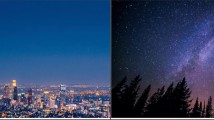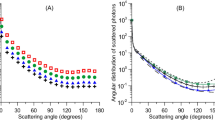Abstract
Nighttime light pollution mars the view of the night sky, wastes energy, and adversely affects ecosystems and human health. In environmental design, efforts to reduce light pollution have often focused on the use of cutoff light fixtures to direct light toward the ground rather than skyward. The results of this study, however, indicate that light-fixture-oriented solutions are not a sufficient response to the problem. The study examined the relationship between nighttime light pollution and land-use types and found that some land-use types and their associated ground materials produce reflected light that contributes to light-pollution levels. As a first step to studying the relationship of land-use types to light pollution, a new method of acquiring high-resolution (sub-30-cm resolution) nighttime aerial images was developed to depict the reflected brightness of artificial lighting with a high degree of accuracy. Once the high-resolution imagery was acquired, 11 land-use types were delineated in the study area based on inspection of daytime aerial images and site visits. Finally, land uses and the nighttime image were compared, and an association between land-use types and nighttime light pollution levels was established. The general finding is that land-use types associated with highly reflective materials, such as concrete parking structures, reflect large amounts of light, producing light pollution even when full cutoff lights are used.



Similar content being viewed by others
References
Adrian W, Jobanputra R (2005) Influence of pavement reflectance on lighting for parking lots. Portland Cement Association, Skokie, pp 5–8
Baldridge AM, Hook SJ, Grove CI, Rivera G (2009) The ASTER spectral library version 2.0. Remote Sens Environ 113(4):711–715
Bell S (1999) Tranquility mapping as an aid to forest planning. UK Forestry Commission, Information Note March (1999), pp 1–6
Borg V (1996) Death of night. Geogr Mag 68:56
Brest CL, Goward SN (1987) Deriving surface albedo measurements from narrow band satellite data. Int J Remote Sens 8(3):351–367
Chalkias C, Petrakis M, Psiloglou B, Lianou M (2006) Modeling of light pollution in suburban areas using remotely sensed imagery and GIS. J Environ Manage 79:57–63
Cinzano P, Falchi F (2012) The propagation of light pollution in the atmosphere. Mon Not R Astron Soc 427:3337–3357
Cinzano P, Falchi F, Elvidge CD, Baugh KE (2000) The artificial night sky brightness mapped from DMSP operational linescan system measurement. Mon Not R Astron Soc 318:641–657
Cinzano P, Falchi F, Elvidge CD (2001) The first world atlas of artificial night sky brightness. Mon Not R Astron Soc 328:689–707
Crawford DL (2000) Light pollution: an environmental problem for astronomy and for mankind. Memorie della Società Astronomia Italiana 71:11–40
Doll CNH, Muller JP, Elvidge CD (2000) Night-time imagery as a tool for global mapping of socio-economic parameters and green-house gas emissions. Ambio 29(3):157–162
Elvidge CD, Baugh KE, Kihn EA, Kroehl HW, Davis ER, Davis C (1997) Relation between satellite observed visible-near infrared emissions, population, and energy consumption. Int J Remote Sens 18(6):1373–1379
Isobe SI, Hamamura S (2000) Light pollution and its energy loss. Astrophys Space Sci 273:289–294
Shaflik C (1997) Environmental effects of roadway lighting (technical paper 9). Dept. of Civil Engineering, University of British Columbia
Stockton GR (2004) Aerial infrared thermography. Downloaded from http://www.stocktoninfrared.com/aerial-infrared-thermography/
Yeang K (2008) Ecodesign: a manual for ecological design. Wiley, London
Acknowledgments
We thank Herb Lingl of Aerial Archives for providing the aerial image.
Author information
Authors and Affiliations
Corresponding author
Rights and permissions
About this article
Cite this article
Kim, M., Hong, SH. Relationship between the reflected brightness of artificial lighting and land-use types: a case study of the University of Arizona campus. Landscape Ecol Eng 11, 39–45 (2015). https://doi.org/10.1007/s11355-013-0234-7
Received:
Revised:
Accepted:
Published:
Issue Date:
DOI: https://doi.org/10.1007/s11355-013-0234-7




